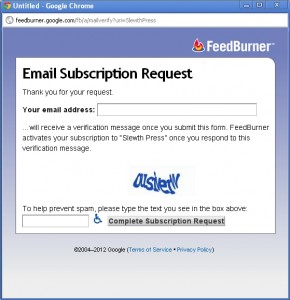Moving on from Feedburner: An accessible alternative for WordPress
A few days ago I made a small but significant change to my blog, thanks to a brilliant post on an accessible email subscription plug-in for WordPress by Laura Legendary in her blog post “Try this accessible tool to increase blog readership“. Laura identifies the Subscribe2 plugin and it’s associated widget in terms of their benefits to her readership. Up until this point, I had used Google’s feedburner to handle subscription interest. However, I have always had concerns about Feedburner. It is a great tool, particularly in terms of analytics. But it is one that requires a subscriber to enter their email address and then complete a CAPTCHA test. Subscribe2 does not ‘test’ subscribers in this way; it requires only an email address and confirmation – with significant accessibility benefits as a result.

CAPTCHA is a contrived acronym for ‘Completely Automated Public Turing test to tell Computers and Humans Apart’. It usually appears in the form of a distorted image of a word that must be decoded in a challenge and response test. The inaccessibility of CAPTCHA remains a well known, well critiqued, but nonetheless-persistent force in social media and hence accessibility circles. In my own experience, during my PhD research with disabled students, CAPTCHA was identified as a significant access barrier for those with visual impairments, exposing one of the mundane rituals required for registration on any social media site as deeply problematic. I discuss this in my thesis as follows, highlighting the experiences of student Claire to evidence this access barrier, in this case in the use of Facebook and other social media.
“Threshold Barriers”
“For Claire, CAPTCHA presented a significant barrier. To enter any ‘networked public’ CAPTCHA requires the user to recognise and reproduce a distorted image of letters that appear on screen. This image is designed to be invisible to machines – specifically spamming robots – however, this fact also renders the image contained in the text invisible to screen readers. As a result, Claire cannot complete registration. Claire does not find the audio equivalents featured on more progressive websites much easier, as the ‘sound’ of the word is also distorted to thwart computers:
There’s a CAPTCHA to sign in, so I struggle with that. I can see if I have to, but obviously, the screen reader is not going to get anywhere with that and the audio ones – Facebook has an audio one – but the audio ones have to be distorted, so that a computer can’t pick it up, and they’re so distorted that you can’t hear them anyway. And what happens sometimes, is, I don’t know if you can see here with the log-in [See figure 6.1]. It gets cut off. So on a site I tried to sign up to the other day you had only half the CAPTCHA, so you couldn’t read it, so there’s absolutely no hope.
(Claire) p256″